By wogwpa1358 on September 10, 2012 / Health
Tags:
bacteria-infused turkey,
BPA in cans,
Carolyn Parrs,
E. coli bacteria,
FDA,
Flunixin,
heavy metal oatmeal,
imported shrimp,
Ivermectin,
local grass-fed beef,
medication in beef,
moldy berries,
MRSA,
pink slime,
rocket fuel lettuce,
salmonella,
United States Department of Agriculture,
women in green,
women of green

Think pink slime is gross? Wait ’til you see what other unappetizing secrets lurk within your grocery store.
1. “Pink slime”
The gross factor: The meat industry likes to call it “lean finely textured beef,” but after ABC News ran a story on it, the public just called it what it looks like — pink slime, a mixture of waste meat and fatty parts from higher-quality cuts of beef that have had the fat mechanically removed. Afterwards, it’s treated with ammonia gas to kill Salmonella and E. coli bacteria. Then it gets added to ground beef as a filler. Food microbiologists and meat producers insist that it’s safe, but given the public’s reaction to the ABC News report, there’s an “ick” factor we just can’t overcome. The primary producer of pink slime just announced that it’s closing three of the plants where pink slime is produced, and Kroger, Safeway, Food Lion, McDonald’s and the National School Lunch Program (among others) have all pulled it from their product offerings.
Eat this instead: Organic ground beef is prohibited from containing pink slime, per National Organic Program standards, so it’s your safest bet. If you can’t find organic, ask the butcher at your grocery store whether their products contain the gunk.
Continue reading... →









